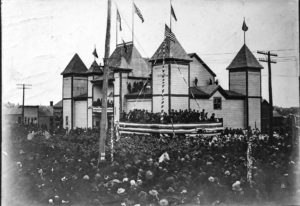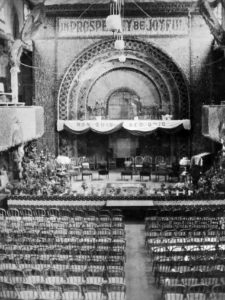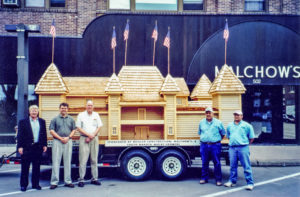

Twelve years have quickly flown by since my book, Palaces on the Prairie, was published by the North Dakota Institute for Regional Studies (now North Dakota State University Press). The Aberdeen Grain Palace was featured in the book, and since 2009, several people have written various accounts of our palace. When I was asked to write this article, I decided to approach the subject from a slightly different angle—namely, what can we learn from our ancestors’ efforts, and can their successes and failures provide valuable lessons for today’s city leaders?

A view from the corner of Fifth Avenue and Main Street looks south at the Grain Palace. Community events attracted hundreds and included visits by Teddy Roosevelt and Presidents McKinley and Taft.
Some people may have been surprised by the fact that Aberdeen’s palace didn’t even make the book’s front cover. That honor went to Mitchell’s Corn Palace—not the current one, but the first of three, which I consider the quintessential example of what a fairytale building should be. If we’re going to be honest, we have to admit that Aberdeen’s Grain Palace was rather plain by comparison. Was that by design? Not at all. The design was stunningly beautiful, and architect E.W. Van Meter did his best to capture the essence of the handsome Main Building at Philadelphia’s Centennial Exposition of 1876.
Women were tasked with decorating the interior of the Aberdeen Grain Palace, and they met or exceeded all expectations. Men were expected to ornately decorate the exterior, and they failed miserably. They only managed to put a strip of grass across the facade, which a local newspaper proclaimed had “enough grain decorations to indicate its character.” Right. The women were led by the Misses Purvis of Minneapolis, both of whom were hired for their decorating skills. Perhaps that gave the women a distinct advantage over the men, who were left to sort things out on their own.
The 1893 Grain Palace Exposition ended on a sour note. A wedding was billed as the final event, but the unfortunate groom was left at the altar.
To be fair, many men did help with the actual construction, and luckily, D.M. Birdseye, a carpenter from Ipswich, was hired to oversee the process. Otherwise, the 60-foot center tower might have been a wobbly, ten-foot cone without a peak. Even so, the building was only “practically completed” in time for the opening ceremonies. A quick coat of white paint was splashed over the outside with the feeble explanation that the architect intended the building “to resemble the World’s Fair buildings in color.”

It was estimated that President William McKinley drew a crowd of over 20,000 people to Aberdeen (population 5,000) when he spoke at the Grain Palace in 1899.
The World’s Fair in question was Chicago’s Columbian Exposition of 1893, and its buildings were referred to as “The White City.” That event had something else in common with Aberdeen’s celebration—it was supposed to have been held in 1892, as it was intended to celebrate the 400th anniversary of Columbus’ discovery of America, regardless of the fact that Columbus didn’t actually discover America. Several Aberdeen families traveled to Chicago for the Exposition, which ran from May 1 through Oct. 31, and some of them were naively optimistic enough to expect Chicagoans to return the favor by attending Aberdeen’s “Inter-State Grain Palace Exposition and Harvest Festival,” scheduled for Sept. 11-23. The Aberdeen Daily News went so far as to claim that thousands would come west from the World’s Fair.
The primary organizers of the Grain Palace were perhaps guilty of naivety in other areas as well. The reason “Inter-State” was added to the exposition’s official name was because Aberdeen organizers invited four nearby counties—Edmunds, McPherson, Campbell, and Walworth—to become partners in the local endeavor. They were urged to voice their support, contribute displays, and donate a significant amount of money.
Admission to the 1893 Exposition was 50 cents but was reduced to 25 cents for “Woman’s Day.”
Campbell and Walworth counties were perhaps too far west to be closely involved with Aberdeen’s exposition, but McPherson County might have been a close partner if Aberdeen had been willing to call their expo building a wheat palace. Eureka, near the western edge of McPherson County, billed itself as the “Wheat Capital of the World” in 1892 and could have benefited from the added publicity. Even though I could find no specific evidence to support my opinion, reading between the lines leads me to believe that Aberdonians didn’t want Eureka to get quite that much attention, and therefore opted for “Grain Palace” instead of “Wheat Palace.”

This is about the only picture that exists of the inside of the Grain Palace. The women of Aberdeen were responsible for decorating it for events.
Edmunds County was quite eager to participate, largely because of Ipswich’s mover and shaker, Joseph Parmley, who was quick to throw his support behind nearly any project that would benefit the area. He attended many organizational meetings and was primarily responsible for the Edmunds County display that captured first prize at the festival. However, his enthusiasm for Aberdeen dwindled rapidly when the Grain Palace Association failed to pay Edmunds County its $300 prize money.
Didn’t anybody advise the association against burning bridges? Well, yes, the editor of Ipswich’s local newspaper did, and he got right to the point: “If Aberdeen ever expects to have another interstate grain palace she is making a serious mistake in attempting to repudiate lawful debts at this time.” Since there was no boasting of profits garnered from the 1893 Exposition, coffers were probably dry.
So, why did Aberdeen build a palace in the first place? The simple answer—because Mitchell did. Why did Mitchell build a palace? The equally simple answer—because Plankinton did.
When Plankinton built South Dakota’s first “palace” in 1891, it is quite possible that leaders from both Mitchell and Aberdeen scoffed at Plankinton’s audacity and wondered why Plankinton’s 600 citizens thought they could tackle such an undertaking when much larger Sioux City threw in the towel after herculean efforts to achieve financial success during the previous five years.
Plankinton’s Grain Palace, though modest in nature, gained enough positive press that at least a few Mitchell businessmen were embarrassed by the thought of being upstaged by a much smaller town. They quickly began organizing the 1892 Corn Palace, and that got Aberdeen’s attention enough for a local newspaper editor to call on Aberdonians to build a palace of their own. Mitchell’s residents quickly kicked into high gear, but Aberdeen’s didn’t. It took another year for Aberdeen to even get out of low gear. (Actually, the first car didn’t appear in Aberdeen until 1900—a Winton—and it likely had only one forward gear.)
The first “moving picture” in Aberdeen was shown at the Grain Palace in 1897.
Other South Dakota towns—such as Ipswich, Gregory, Timber Lake, Rapid City, and St. Francis—waited until the early 1900s to stake their claims. Four of those towns abandoned their efforts after the first year, but Ipswich kept decorating a railroad car as their Corn Palace from 1909 into the 1920s.
Aberdeen struggled financially through nine years of yearly harvest festivals until the palace burned in 1902. Only Mitchell’s Corn Palace has survived, but not without struggles of its own. Their 1892 and 1893 expositions managed to turn a small profit, but then, except for occasional weddings or other private events, the building basically sat idle for the next six years.
Cities in other states—Illinois, Nebraska, Missouri, and Texas, for example—jumped on the Sioux City Corn Palace bandwagon before South Dakota towns did. Each of the communities found something different to promote, ranging from corn and wheat, to alfalfa, flax, blue grass, cotton, sugar, coal, gold, and even ice! Dissimilar as they may have been, they all had one thing in common—they struggled to be profitable on their own. What was the problem?

While this building never really lived up to the artist’s vision, Aberdeen’s Grain Palace needed to be finished and opened for the season. This 1893 view shows the building under construction exactly where Malchows Furniture would later be located. It is now the site of Malchow Plaza. The Grain Palace burned to the ground in 1902 and was never replaced.
Most community activities relied heavily on volunteers, and the larger the project, the more volunteers were required. Massive projects, such as Corn Palace Expositions, demanded so much commitment that even the most dedicated citizens suffered from burnout. In addition, visitors did not want to see the same thing year after year, so events needed to be in a constant state of reinvention. Even highly paid professionals found that to be a daunting task, so it was no wonder the various palaces found survival nearly impossible.
Even today, many Mitchell residents question whether their Corn Palace is worth the financial commitment required for the building’s upkeep, but city leaders have determined that the attraction draws an adequate number of visitors to provide a positive business climate throughout the city. We might be tempted to call businessmen in the early 1900s short-sighted for not considering residual benefits of a palace, but then again, there wasn’t the ease of travel a hundred years ago that there is today; therefore, tourists weren’t as likely to stop by for a visit while passing through.
The Aberdeen Grain Palace was not a smashing success, which was evidenced by the fact that it was not rebuilt after the fire. Nor did it turn Aberdeen into the next Chicago, as some boasted it would. However, does that mean it wasn’t worth the effort? What does it take to consider a grain palace successful?
In 1897, an automobile arrived on the local train so it could be put on display at the Grain Palace. As the car-the only one in town-was being driven down Main Street, it crashed into a traveling salesman from New York. Luckily, the car and the salesman escaped relatively unscathed.
One measure of success perhaps lies in the fact that when Aberdonians talk about the city’s history, the first thing that often comes to mind is the Grain Palace, even though no one alive today saw it or experienced the thrills provided by the yearly expositions. It still seems to be a source of pride, so what does that tell us? Does it hint that perhaps early businessmen and leaders were more forward-thinking than they’re given credit for? Does it indicate that a second palace should’ve been built, one that was perhaps more awe-inspiring? Or does it tell us the palace would have been successful if women had been given more opportunities to hold city offices and managerial positions within companies?
Is the idea of a grain palace or some other type of spectacular structure outdated, or is this a case where the wheel could actually be reinvented? In 2003, I thought a model of the 1893 Grain Palace would be an excellent promotional tool, so I contacted Tom and Mark Malchow about the idea because the original palace was built on what would later become the Malchow Furniture Main Street site. They liked the idea and offered to help finance it. I then contacted Campbell’s Town & Country and South Dakota Wheat Growers (now Agtegra) about helping, and they agreed. Lastly, I visited with contractors Richard and Matt Biegler, who happened to be building a house across the street from us. The Bieglers thought building the model Grain Palace would be loads of fun, and they offered to construct it at no charge.

In 2003, author Rod Evans conceived of the idea to build a scale model of the Grain Palace and photographed it near its original location. Sponsors of the project included (from left) Dale Locken, (SD Wheat Growers/Agtegra), Mark Malchow, Tom Malchow, Richard Biegler, and Matt Biegler of Biegler Construction.
The large, beautiful model fit perfectly on my 18-foot trailer, and it was such a crowd-pleaser that adults would wave as I drove by, and kids—cheering and grinning from ear to ear—would follow me down the streets on their bicycles. Crowds gathered around it when I put it on display at the former Oz & Dakota Heritage Festival, and more recently it has garnered attention at the Centennial Village during the Brown County Fair. The question is, would a new, large-scale Grain Palace have the same appeal?
In my opinion, the main reason the original palaces faced insurmountable financial obstacles was because they were built with only one purpose in mind—to promote an annual festival. The buildings’ finances were dependent on one or two weeks of large crowds, good weather, available entertainment, and no unpleasant surprises.
At about the time the Grain Palace model was built, several Aberdeen citizens gathered to discuss the possibility of building a multi-purpose palace. Those in attendance were very much in favor of the project, and the Aberdeen American News publisher at the time, Adrian Pratt, wrote an editorial to show his support. Unfortunately, people who could actually steer such a project to reality stayed in the background, and the idea remained just that.
The main attraction at the 1899 Grain Palace Exposition was Doc Carver’s diving horses. Cupid, the crowd favorite, turned a mid-air somersault after leaping from the diving platform.
Even though a new Grain Palace was not to be, Aberdeen can still be proud of Storybook Land with its castle, along with its many other enticing attractions. Think of the possibilities if the area could only be covered with a dome—retractable, of course! And what was once the original gathering place, the corner where the Grain Palace once stood is now Malchow Plaza, a space growing in popularity in Aberdeen. We can also be proud of the Downtown Aberdeen Revitalization Team (DART) and the work they’re doing to save the city’s Main Street heritage. My hat is off to Rod Fouberg, Rod Tobin, Tom Hurlbert, Heath Johnson, and others. I just wish they also had a beautiful Grain Palace to preserve. //
 Summary of Rod Evans’ book, Palaces on the Prairie:
Summary of Rod Evans’ book, Palaces on the Prairie:
From the 1880s to the 1930s, at least 34 “prairie palaces” of one sort or another sprang up in at least 24 towns across the Midwest. Their themes ranged in scope from grasses to grains to minerals, but all sought the same goal—attention! Evan’s book attempts to tackle many unanswered questions surrounding the success and failures of each palace and community.
You can buy his book online here.
















